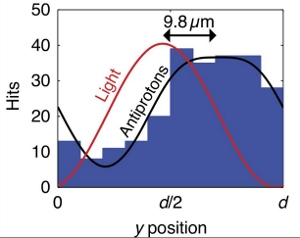First application of a Moiré deflectometer in antimatter physics
The AEgIS Collaboration at CERN (an international consortium of 25 institutions1) has observed the shadow pattern of antiprotons produced by a tool from atom optics, the moiré deflectometer, consisting of two identical gratings and an emulsion detector. The concept is also straightforwardly applicable to antihydrogen measurements as pursued by the AEgIS collaboration. The combination of these very different techniques from high energy and atomic physics opens a very promising route to the first direct detection of the gravitational acceleration of neutral antimatter.
The principle of the deflectometer is shown in the fig (a). A beam of antiprotons – the antimatter counterparts of the proton – from CERN’s Antiproton Decelerator, is slowed down by thin foils before traversing a several meters long vacuum tube placed in a strong londitudinal magnetic field. Any obstacle on the antiproton path leads to its annihilation into secondary particles, such as pions. A modulation of the antiproton intensity („moiré“ pattern) is observed by the annihilation detector when obstructing the antiproton beam by a pair of gratings. The gratings are etched in silicon wafers, have a periodicity of 40µm and openings that are 12µm wide. With a de Broglie wavelength of the antiprotons being estimated to be around 10-13 m, the trajectories of the antiprotons are strictly classical. The distance L separating the two gratings (25 mm) is equal to that between the second grating and the detector, made of emulsions, namely photographic films especially developed for applications in nuclear and particle physics. Fig. (b) shows the tracks left in the emulsions by the annihilation products from antiprotons, observed with an automatic optical microscope. The “fat” tracks are due to nuclear fragments flying apart, the faint tracks to pions. Emulsion detectors measure the annihilation point with an unbeatable precision of 1-2 micrometer.
A force, perpendicular to the grating’s slits, acting on the antiprotons leads to a shift of the observed shadow pattern. This shift is measured by comparison of the antiproton measurement with a measurement with light. For light, the two gratings act as a Talbot-Lau interferometer – creating reference fringes that are not subject to forces, thus providing the undeflected position. The phase difference between both measurements is a direct measure of a force acting on the antiprotons. Fig. (c) shows that such a force is actually present. Its magnitude is very tiny, about 500 aN (attonewtons, or 5 x 10-16 newton, 10 newton being the weight of a 1 kg mass) leading to a displacement of the shadow fringes by about 10 microns. The force is either due to a slight electric field gradient of 33 V/cm or to a small transverse magnetic field component of about 7.4 gauss, encountered by the antiprotons along their 5 cm long path through the moiré deflectometer.
This result, achieved by combining very different techniques employed in the fields of atomic and particle physics, constitutes the first observation of moiré patterns with antimatter. This paves the way for detailed comparisons of the fundamental properties of antimatter with those of normal matter, such as its behavior under the influence of gravity.



1 AEgIS collaboration:
Politecnico di Milano, Piazza Leonardo da Vinci 32, 20133 Milan, Italy.
Istituto Nazionale di Fisica Nucleare, Sez. di Milano, Via Celoria 16, 20133 Milan, Italy.
Physics Department, European Organisation for Nuclear Research, 1211 Geneva 23, Switzerland.
Laboratory for High Energy Physics, Albert Einstein Center for Fundamental Physics, University of Bern, 3012 Bern, Switzerland.
Institute for Nuclear Research of the Russian Academy of Sciences, Moscow 117312, Russia.
Department of Mechanical and Industrial Engineering, University of Brescia, Via Branze 38, 25133 Brescia, Italy.
Istituto Nazionale di Fisica Nucleare, Sez. di Pavia, Via Agostino Bassi 6, 27100 Pavia, Italy.
Kirchhoff Institute for Physics, Heidelberg University, Im Neuenheimer Feld 227, 69120 Heidelberg, Germany.
Department of Physics, University of Trento and TIFPA-INFN, Via Sommarive 14, 38123 Trento, Italy.
Laboratoire Aime Cotton, CNRS, University of Paris-Sud, ENS Cachan, Baˆtiment 505, Campus d’Orsay, 91405 Orsay, France.
Physics Institute, University of Zurich, Winterthurerstrasse 190, 8057 Zurich, Switzerland.
Department of Physics, University of Milan, Via Celoria 16, 20133 Milan, Italy.
Max Planck Institute for Nuclear Physics, Saupfercheckweg 1, 69117 Heidelberg, Germany.
Istituto Nazionale di Fisica Nucleare, Sez. di Genova, Via Dodecaneso 33, 16146 Genoa, Italy.
Institute of Physics and Technology, University of Bergen, Alle gaten 55, 5007 Bergen, Norway.
Department of Physics, University of Oslo, Sem Sælandsvei 24, 0371 Oslo, Norway.
Department of Physics, University of Genoa, Via Dodecaneso 33, 16146 Genoa, Italy.
Stefan Meyer Institute for Subatomic Physics, Austrian Academy of Sciences, Boltzmanngasse 3, 1090 Vienna, Austria.
Department of Physics, University of Pavia, Via Bassi 6, 27100 Pavia, Italy.
Joint Institute for Nuclear Research, Dubna 141980, Russia.
Istituto Nazionale di Fisica Nucleare, Sez. di Padova, Via Marzolo 8, 35131 Padua, Italy.
Institute of Nuclear Physics of Lyon, CNRS/IN2P3, University Lyon 1, 69622 Villeurbanne, France.
Czech Technical University in Prague, FNSPE, Brehova 7, 11519 Prague 1, Czech Republic.
Department of Physics and INFN Bologna, University of Bologna, Via Irnerio 46, 40126 Bologna, Italy.
Department of Physics, University of Napoli Federico II, Via Cinthia, 80126 Naples, Italy.
Correspondence and requests for materials should be addressed to P.B. (email: antiprotons@matterwave.de).
